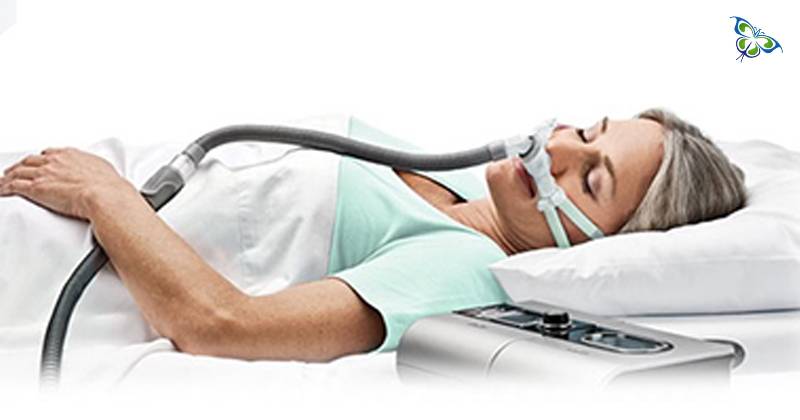
Hello
Select Address

Sleep apnea is an intensifying disorder in 3 out of 10 adults and is a severe case in 1 out of 15. It is a potential sleep disorder that causes difficulty in breathing. The most common and recommended treatment for sleep apnea is CPAP therapy (continuous positive airway therapy). A CPAP machine employs gentle air pressure to keep the airways clear enough to reduce breathing problems. It is important to know more about the machine and its components to make the treatment more comfortable.
A CPAP machine comes with a nasal mask that is attached to the nostrils, a motor that blows air and tubes to channel the air to the mask.
CPAP masks come in three basic varieties -
Full Face mask to cover the entire nose and the mouth,
Nasal Pillow mask to supply air directly to the nostrils, and
Nasal mask to supply air to the bottom of the nose.
What is a Nasal Pillow Mask?
Unlike the Nasal mask that covers the entire nose, Nasal pillow mask fits exactly at the nostrils using a seal and directs the airflow right through the nose. The term pillow depicts the cushion structure that seals the nostrils area. Nasal pillow masks are less hefty and more comfortable for people with claustrophobic tendencies. They provide complete vision to the person wearing, unlike a full-face mask.
What are the essential parts of a Nasal Pillow Mask?
1. Nasal Seal: Nasal seals are replacement cushions or pillows for the nasal mask system. These seals are generally made of silicone, gel or foam. Nasal seals are recommended to be cleaned daily to wash away facial oils that make the masks air-leak prone. Nasal seals are to be replaced every 3-6 months. Discolored seals or heavy leakage causes discomfort and is a sign of seal replacement.
2. Mask Headgear: the main objective of the CPAP headgear is to hold the mask in position and keep its air passageway sealed. These headgears are generally made of soft and yielding material like synthetic neoprene that is resistant to oils and abrasion. Some headgears are made of silicone while some are attached with Velcro-fasteners and clips to attach to the frame. These headgears come in ‘one size fits all’ and go around the head using straps attached to it.
3. Mask Frame: A mask frame holds all the components of the nasal pillow mask together. It holds the pillow along with the breathing tubes and the headgear, all in place. CPAP mask frames are available in a variety of sizes based on the rest of the equipment and to fit varied facial structures. Nasal pillow mask frames provide the least coverage in comparison to the other masks.
4. Swivel: A CPAP swivel is a small cylindrical body made of plastic. It connects the CPAP tubing to the mask. Swivels are small and can sometimes get stuck in the CPAP tubing. Often CPAP users get confused about their masks not working or the hose not fitting and may even replace it for malfunctioning. However, it can be a swivel problem.
5. Tubing Elbow: A tubing elbow is an adaptor with a bent structure at a 90-degree angle. It is used to connect the hose to the CPAP machine at a steady angle to reduce stress on the tubing and allow more flexibility from the machine to a bed. The objective is to sleep comfortably even with a CPAP mask on.
6. Mask Diffuser: A CPAP mask diffuser is a small filter that fits between the diffuser cover and the elbow. It can also be placed at the swivel. The main function of the diffuser is to reduce noise that the mask can make.
7. Chin Strap: Chin straps are specially designed for mouth breathers. These are flexible, stretchy bands made out of soft materials to keep the mouth closed while sleeping at night. These help mouth breathers use CPAP masks effectively. Some masks are seamless while some have Velcro tabs attached to them.
8. Forehead Pad: Continuous use of nasal pillow masks can cause irritation and pain. Forehead pads create a barrier between the mask and the skin of the user. These forehead pads are made of silicone or gel; they help reduce vexation and red marks in the strap and frame area.
When to replace which component?
With time nasal pillow masks become less effective. The oil discharge from the skin deteriorates the pillows and the masks, this cause air leakage. Each of the components has a quality time frame after which they need replacement:
How to clean nasal mask components?
To obtain a reasonable life span of the components, each of the parts is to be thoroughly cleaned. The nasal pillow should be wiped every morning with a damp flannel cloth to clean up facial oil residue. All the parts of the mask are to be properly dismantled and thoroughly washed every week with original washing liquid and fresh clean water after which it should be dried in a radiator or direct sunlight. No amount of moisturizers, bleaches or antibacterial agents are to be used while cleaning a nasal mask.
Replacement of components from time to time is highly recommended for effective CPAP therapy and a backup mask must be in hand in case the present one malfunctions.
Validate your login
Sign In
Create New Account